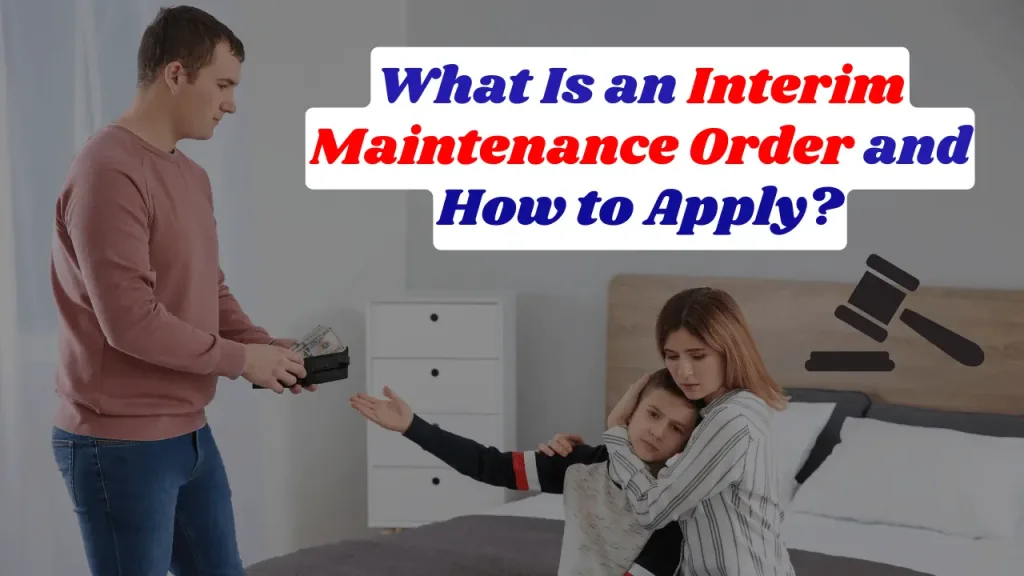What Is an Interim Maintenance Order and How to Apply?
Divorce can feel like an emotional and financial rollercoaster, especially when the pressure of immediate financial needs weighs heavily before a final settlement is reached. Whether it’s covering daily living costs, paying bills, or handling legal expenses, the stress of managing finances during this turbulent time can be overwhelming. For those who find themselves struggling, an interim maintenance order can provide the vital lifeline needed to bridge the gap.
This temporary financial support ensures that you don’t have to wait for the lengthy divorce process to conclude before receiving the help you deserve. In this article, we’ll take a closer look at what an interim maintenance order is, how you can apply for it, and the factors the court will consider. We’ll also delve into the risks and offer expert tips on how to undertake the process with the best chance of success.
Table of Contents
What Is an Interim Maintenance Order?
An interim maintenance order, also known as maintenance pending suit, is a temporary financial arrangement issued by the court to provide financial support to one spouse while divorce proceedings are ongoing. This support helps cover essential living expenses such as rent, utilities, food, and mortgage payments until a final financial settlement is reached. Interim maintenance can also include support for children who are dependent on one spouse.
This type of order is particularly important when there is a significant financial disparity between the spouses, and one party is unable to meet their basic needs while awaiting a final settlement.
Why Is Interim Maintenance Important?
The divorce process can be lengthy, sometimes taking over a year for financial settlements to be finalized. During this period, many spouses, especially the financially dependent one, may find themselves in a precarious financial position. Without interim maintenance, they might struggle to afford everyday living expenses, which can further complicate the emotional and financial strain of divorce.
Interim maintenance helps avoid such hardship by providing essential financial relief, allowing both parties to focus on the legal process rather than immediate survival. It ensures that the spouse with lesser financial resources does not suffer while awaiting a long-term resolution.

How Does the Court Determine Interim Maintenance?
When applying for an interim maintenance order, the court will assess several factors to determine the amount and duration of the payment. These factors include:
1. The Financial Position of Both Parties
The court will consider the income, assets, and financial needs of both parties, including income from all sources, such as employment, state benefits, and pensions. The financial disparity between the parties is a significant consideration, with the court focusing on the needs of the dependent spouse and the ability of the other spouse to make payments.
2. Standard of Living During the Marriage
The court takes into account the standard of living that both parties enjoyed during the marriage. This helps the court determine the reasonable needs of the dependent spouse to maintain a similar lifestyle during the divorce proceedings.
3. Urgency and Immediate Need
Interim maintenance is designed to address immediate financial needs. The court generally takes a “rough and ready” approach, making quick decisions based on the urgency of the situation rather than a detailed forensic assessment of assets.
4. Ability to Pay
The financial capacity of the spouse who may be required to make the payments will also be assessed. If the paying spouse has substantial income or assets, the court is more likely to order them to provide interim support.
How to Apply for Interim Maintenance?
1. Voluntary Agreement Between Spouses
In some cases, the spouses may agree to an interim maintenance arrangement without involving the court. This can be done through mediation or direct negotiation with the assistance of solicitors. If an agreement can be reached, it should be formalized in writing and submitted to the court for approval.
2. Court Application
If the parties cannot agree, an application for an interim maintenance order can be made to the court. The applicant must complete the necessary forms, including Form D11 (to apply for an interim order as part of divorce proceedings) and a Statement of Information outlining the applicant’s financial position and the requested amount of support.
The application will be accompanied by a detailed budget that outlines the applicant’s financial needs, including housing costs, utilities, groceries, and other essential expenses. It is also advisable to provide a Form E, which includes detailed financial disclosure, although this may not always be required for interim orders.
3. Court Hearing
Once the application is submitted, the court will arrange a hearing. During the hearing, the judge will review the submitted documents and may ask both parties questions to clarify their financial situations. The hearing is typically brief, with the judge making a decision based on the urgency of the financial need and the available evidence.
4. Legal Costs
Applying for an interim maintenance order can be expensive, as court fees and legal costs may be involved. However, the costs should be weighed against the potential relief that interim maintenance can provide. In some cases, the court may order one party to pay the legal costs of the other, depending on the outcome of the application.
Related Articles For You:
Disadvantages of Legal Separation in the UK
Risks and Considerations
While applying for interim maintenance can provide crucial financial support, there are certain risks to be aware of:
1. Legal Costs
Interim maintenance applications can be costly, and the usual rule in family law that each party pays their own legal costs does not apply here. If the application is unsuccessful, the applicant may be required to pay the opposing party’s legal costs in addition to their own.
2. The Court’s Broad Approach
The court takes a broad approach when considering interim maintenance orders, as the hearings are typically short. As a result, the judge may rely heavily on the documents submitted and initial impressions, rather than conducting a detailed forensic analysis of the financial situation.
3. Backdating of Payments
In some cases, interim maintenance payments can be backdated to the date of the divorce petition, which can be especially helpful in addressing immediate financial needs or debts incurred during the divorce process.
How Long Does an Interim Maintenance Order Last?
An interim maintenance order typically lasts until a final financial settlement has been reached in the divorce proceedings. This can take several months or even years, depending on the complexity of the case.
In some cases, the interim maintenance order may be extended if additional time is needed to resolve the financial issues. Once the final settlement is made, the interim order is typically replaced by a final spousal maintenance order, which may either increase, decrease, or end depending on the circumstances.
Expert Insights on Interim Maintenance
According to Elinor Feeny, a Partner in Family and Divorce Law, interim maintenance is vital for ensuring that the financially dependent spouse does not suffer during the divorce process. “The court has the power to act swiftly and grant interim orders to meet urgent financial needs. These orders help provide immediate relief while the divorce proceedings are ongoing, ensuring the weaker party is not left in financial hardship,” says Feeny.
Additionally, case law such as Rattan v Kuwad [2021] EWCA Civ 1 emphasizes that interim maintenance can be awarded based on a spouse’s demonstrated need and the payer’s ability to contribute. The judge in this case ruled that the spouse’s needs, as outlined in their financial disclosure, were sufficient to justify interim support without the need for a fully detailed forensic analysis of assets.
Practical Tips for Applying for Interim Maintenance
- Seek Legal Advice Early: It is crucial to consult with a family lawyer at the earliest stage to understand your eligibility for interim maintenance and prepare your application effectively.
- Provide Detailed Financial Records: Ensure you have clear and accurate records of your income, expenses, and financial needs to support your application.
- Consider Alternative Dispute Resolution: Mediation or negotiation may be a quicker and more cost-effective route to reaching an agreement on interim maintenance without involving the courts.
- Be Prepared for Court Costs: Understand the potential legal costs involved in applying for interim maintenance, and weigh these costs against the benefits of securing financial support.
Conclusion
An interim maintenance order is a vital tool for ensuring financial stability during the often lengthy and stressful divorce process. Whether you are seeking support or being asked to provide it, understanding the application process and the factors the court considers is essential. With expert legal guidance, it is possible to move through this process effectively, ensuring that both parties’ immediate financial needs are addressed while the divorce proceeds to its final resolution.
References:
- Matrimonial Causes Act 1973, Section 23 (UK)
- Rattan v Kuwad [2021] EWCA Civ 1 – Case Law on Interim Maintenance
About the Author

Sarah Klein, JD, is a former family law attorney with over a decade of courtroom and mediation experience. She has represented clients in divorce, custody cases, adoption, Alimony, and domestic violence cases across multiple U.S. jurisdictions.
At All About Lawyer, Sarah now uses her deep legal background to create easy-to-understand guides that help families navigate the legal system with clarity and confidence.
Every article is based on her real-world legal experience and reviewed to reflect current laws.
Read more about Sarah
